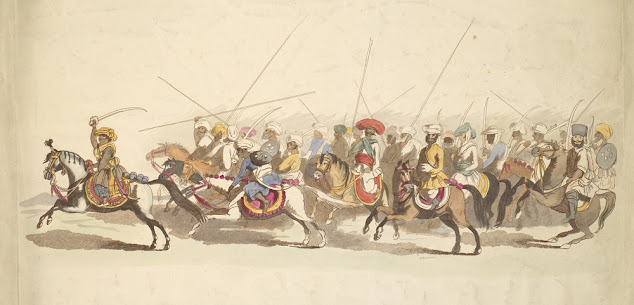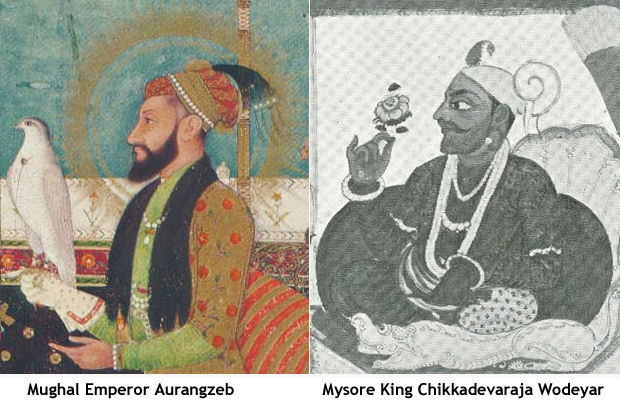The brave Kannadiga villagers of Tumakuru District who fought off Maratha army plunderers
Research and author: Ameen Ahmed
Background
Background
Much of what today is Tumakuru district was an integral part of the Mysore Kingdom during the reign of Haidar Ali and Tipu Sultan, just like their predecessors the Wodeyars. The Third Anglo Mysore War (1790-92) saw large scale invasion of Mysore Kingdom from all sides by the British, Marathas and the Hyderabad Nizam (1). Stretched and clearly unable to protect every inch of their territory, forces of Mysore Kingdom concentrated on protecting big towns and fortifications. The Maratha Armies swept through the region and repeated on a mass scale what they had been doing to Kannadigas since Shivaji's burning and plundering of Karnataka's towns and markets in mid 17th century (2). This is a story of a small village in Tumakuru District whose brave men and women fought off a brutal army to save their lives, honour and property.
The rampaging invaders
After taking Bengaluru pettah (pete) and the fort in March 1791 CE, after a fierce struggle, Cornwallis marched ahead with his army towards Srirangapatna (Seringapatam as the British called it), the capital of Mysore Kingdom. But he struggled to take the place and suffered heavy loss of men, and also cattle that transported his army's gear. He retreated in late May, the same year.
The British misery, however, was short lived. A few days later, Maratha General Parasuram Bahu's army, together with Uhtoff, paymaster of East India Company's Bombay detachment and two battalions of sepoys (Indians serving East India Co.) commanded by Captain Little joined Cornwallis. Uhtoff had 20,000 horse and foot soldiers. A little later, another Maratha army of 12,000 horse led by Hari Pant joined Cornwallis. It had advanced from Pune (Poonah) via Gooty.
The British misery, however, was short lived. A few days later, Maratha General Parasuram Bahu's army, together with Uhtoff, paymaster of East India Company's Bombay detachment and two battalions of sepoys (Indians serving East India Co.) commanded by Captain Little joined Cornwallis. Uhtoff had 20,000 horse and foot soldiers. A little later, another Maratha army of 12,000 horse led by Hari Pant joined Cornwallis. It had advanced from Pune (Poonah) via Gooty.
Instead of turning back and attacking Srirangapatna right away, Cornwallis decided to focus on the forts and towns that were still with the Mysoreans. In early July 1791, Parasuram Bahu's army and Captain Little’s Bombay detachment moved north towards Sira (Tumakuru District), while Cornwallis proceeded back to Bangalore. After making Sira as their base the Maratha soldiers of Parasuram Bahu started raiding nearby villages.
East India Company commissioned Traveler, Writer and Physician Francis Buchanan visited the region nine years later. According to him all villages around the town were plundered. In his diary entry dated 16 August 1800 he writes this after travelling north from Sira to the hill fort of Midigeshi, 'I went three cosses to Madigheshy. The whole country through which I passed was laid waste by the Marattah army under Puseram Bhow; and as yet has recovered very little.' (3)
How the common Kannadigas fought back
Among the villages that Maratha soldiers attacked in the vicinity of Sira in July 1791 was Mooka Nayakanahalli Kote (or M.N. Kote) located in today's Tumakuru District. From his base in Sira, Parasuram Bahu sent 500 horse and 2,000 irregular foot soldiers armed with a cannon to raid the village. It is to be noted that the Maratha irregular foot soldiers were notorious for atrocities across India in the 18th century (4). They were essentially farmers who were hired by rulers to accompany regular armies and thrived primarily on loot and plunder. For them it didn't matter if their victims were Hindus.
But the Kannadigas villagers had a plan in place. The village had around 190 houses in it. About 500 farmers from the neighbourhood organised a defence. To begin with, they destroyed the market and houses near the village to prevent them from being used by the invaders. Buchanan mentions that Kannadigas viewed the horrors of Maratha army cruelty with greatest contempt.
In between them, the defenders had two small cannons and 100 matchlocks which they positioned to take on the invaders. The rest armed themselves with slings and stones. The Maratha soldiers were taken aback as the Kannadiga villagers fought back. The attackers then besieged the village. The well-stocked defenders held on for a full two months. Strong fortified mud walls helped the villagers in their efforts. It is to be noted that Haidar Ali, during his rule over Mysore Kingdom from 1761 to 1782, ensured that village defenses like village walls and hedges were well-maintained, primarily to prevent Maratha attacks (5). Visiting Sira, Buchanan also noted that villages around powerful garrisons were strongly fortified.
Through the siege the Maratha soldiers fired their guns many times but without success. Sometimes the invaders tried to sneak close to the village defense walls but a few of them died as the villagers discharged their muskets. This prevented others from committing the same bravery or foolishness. Throughout the siege not one of the defenders sustained any injuries. Tired, the Maratha Army was forced to retreat.
Buchanan during his visit to villages in the vicinity of Sira observed it was not uncommon for villagers to fight back invaders. He writes, 'In their defence they employ few weapons except stones, which both men and women throw with great dexterity, and equal boldness.'
Buchanan also observes that while villagers did not take on regular soldiers they did not however spare irregular cavalry, whom they usually fought back with stones. Keeping that in mind, the heroics of MN Kote villagers are worthy of being told. He also came across another village chief who boasted how with ten men he had fought off a cavalry of two hundred invading Marathas, that left many attacking men and horses dead.
Rape, plunder and murder by retreating Maratha soldiers
According to Buchanan, as Parasuram Bahu left the area, his Maratha soldiers committed many atrocities on Kannadigas, particularly the women. They forcibly took away all the Kannadiga girls they could find. They looted all the provisions from the villagers which, according to him, resulted in 75% of the area's population dying of hunger. These atrocities were a repeat of what Maratha armies did to the people of Karnataka (erstwhile Mysore Kingdom) for over a century, particularly under the Peshwas.
A map tracing nearly sixty Hindu towns & temples of Karnataka, including M.N.Kote and Sira around which this story is centred, that suffered from the attacks of Maratha Empire in 17 & 18 centuries CE. Updated on 30 Aug. 2020.
Although there are many eye witness accounts, British as well as Indian, of Maratha army brutalities across India, rarely has the successful, brave resistance of an ordinary people against such a brutal Empire been recorded in modern India's history. This glorious tale of ordinary but courageous Kannadigas needs to told and retold for generations to come.
References:1) Moor, Edward., 'A narrative of the operations of Captain Little's detachment, and of the Mahratta army, commanded by Purseram Bhow; during the late confederacy in India, against the Nawab Tippoo Sultan Bahadur', London, J.Johnson, 1794.2) Gazetteer of the Bombay Presidency, vol. XV, Part 2 - Kanara, 18833) Buchanan, Francis., 'A journey from Madras through the countries of Mysore, Canara and Malabar', in 3 volumes, 1807.4) Sarkar, Jadunath., 'Fall of the Mughal Empire', In four volumes, 3rd edition, 19645) Rice, B.L., 'Mysore - A Gazetteer compiled for Government' (Revised Ed.), 1897.







One of the best article I have ever read on the bravery of Kannadigas. I used to visit the present M.N. Kote during 1955 or so. My father used to purchase Mango gardens there. I have seen the walls of the older fort. I very well remember that the village was dominated by Lingayat community. From Tumkur to the village I used to cycle which is about thirty five KM or so. Many congratulations for this article
ReplyDeleteIn 1955, my family(amongst the handful of brahmaNa households) had their mango orchards there with many cultivars of mangoes. It was subsequently lost during land reforms era, mostly my family dealt with your father! I learn orcards have become coconut plantations now. :(
DeleteBig salute for the author for told this untold truths with commandable proofs... We are proud kannadigas should be inspired from this story.. I heard from the localities of channapatna that there was one peshwa in channapatna also. If he see one girl in his way and he feel beutiful, he order his People to bring her. If order so, there was no option for anyone to stop. Parents only should surrender their daughter to him!!
ReplyDeleteIt's horrible..... finally hyderali finished this cruel peshwa and demolished palace at channapatna. We can see the ruins of palace even today.
Thank you ones again for sharing this true facts of history.
Great work Ameen sir. Its almost in the foot steps of chief Nidhin. Keep it up.
ReplyDelete